

SoundCloud | Tech Stacks. Y Combinator Technology Usage. How we use Trello & Google Docs to make UserVoice better every day. Editor’s Note: Need help building an awesome product roadmap?

Don’t forget to check out Get Your Priorities Straight! The Product Manager’s Guide to Smart Product Roadmap Prioritization, our free eBook geared towards product managers facing some tough decisions as they map out the next leg of their product’s journey on their product roadmap. Get the full version for detailed advice on how to prioritize your product roadmap! How Airbnb scaled to 24/7 support in one month. Airbnb has had massive success by being extremely customer-focused.

Despite naysayers, they’ve successfully built a huge business around a community marketplace for people to rent out their homes. People love it, and the company is always trying to figure out how to better help these customers. Last July, Airbnb made a huge decision: to start providing 24/7 support on both email and phone.
As soon as possible. “It was an exciting, global challenge,” says Jessica Semaan, Customer Service Strategy & Planning at Airbnb. Tips for Freelancers on Time Tracking and Invoicing. It's always informative hearing about the tech behind other startups, and it's nice to reciprocate.
So without further ado, here's what keeps things ticking at Paydirt. The application stack Paydirt is a Rails 3.2 app. We're pretty vigilant about staying on the latest version of Rails; it's easy to fall behind, and hard to catch up. We're getting more and more into backbone.js. Our latest big feature improvement makes heavy use of D3.js for graphing. What we’ve learned from Hacker School. We’ve now run two batches of Hacker School and we’re about to start the third.
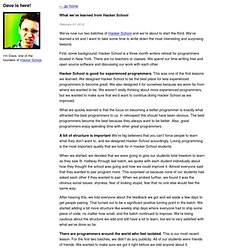
We’ve learned a lot and I want to take some time to write down the most interesting and surprising lessons. First, some background: Hacker School is a three month writers retreat for programmers located in New York. There are no teachers or classes. My Recent Development Stack: OS X Tools « Renowned Media. I made the switch to OS X about half a year ago now, and I must admit I’m going to find it rather hard to go back to using Windows or Linux on the desktop.
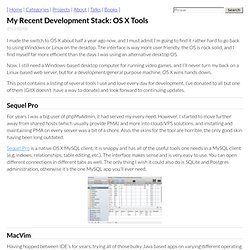
The interface is way more user friendly, the OS is rock solid, and I find myself far more efficient than the days I was using an alternative desktop OS. Now, I still need a Windows-based desktop computer for running video games, and I’ll never turn my back on a Linux-based web server, but for a development/general purpose machine, OS X wins hands down. 7 Years of YouTube Scalability Lessons in 30 Minutes. If you started out building a dating site and instead ended up building a video sharing site (YouTube) that handles 4 billion views a day, then it’s just possible you learned something along the way.
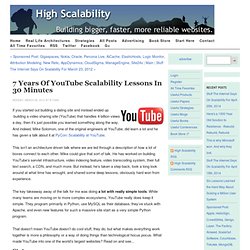
And indeed, Mike Solomon, one of the original engineers at YouTube, did learn a lot and he has given a talk about it at PyCon: Scalability at YouTube. This isn’t an architecture driven talk where we are led through a description of how a lot of boxes connect to each other. Mike could give that sort of talk. How we decreased sign up confirmation email bounces by 50% - Kicksend Blog. Kicksend uses the tried and tested pattern of sending our new users confirmation emails to verify their identity.
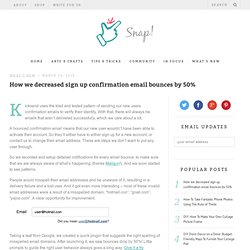
With that, there will always be emails that aren’t delivered successfully, which we care about a lot. A bounced confirmation email means that our new user wouldn’t have been able to activate their account. So they’ll either have to either sign up for a new account, or contact us to change their email address. Divide and Concur. Posted by Noah Sussman | Filed under engineering, infrastructure By Noah Sussman and Laura Beth Denker.
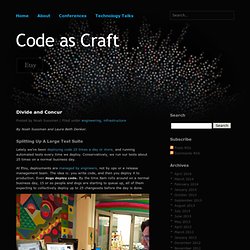
Splitting Up A Large Test Suite Lately we’ve been deploying code 25 times a day or more, and running automated tests every time we deploy. Conservatively, we run our tests about 25 times on a normal business day. At Etsy, deployments are managed by engineers, not by ops or a release management team. If 15 Engineers Deploy 25 Changesets In 24 Hours… Deploys generally take about 20 minutes.
Scaling CI at Etsy: Divide and Concur, Revisited. Posted by LB Denker | Filed under engineering, infrastructure In a past post, Divide and Concur, we told you how we approached dividing our large test suite into smaller test suites by keeping similar tests together rather than arbitrarily dividing.
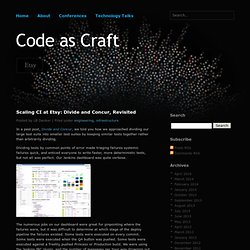
Dividing tests by common points of error made triaging failures systemic failures quick, and enticed everyone to write faster, more deterministic tests, but not all was perfect. Our Jenkins dashboard was quite verbose. The numerous jobs on our dashboard were great for pinpointing where the failures were, but it was difficult to determine at which stage of the deploy pipeline the failures existed.
37signals | Tech Stack/etc. Brack3t | Tech Stack/etc. Facebook | Tech Stack/etc. Trello | Tech Stack/etc. Tumblr | Tech Stack/etc. What We Use: Adam Dachis' Favorite Gear and Productivity Tips. This week we're sharing the hardware, software, tips, and tricks, that keep our blogging wheels spinning.

Today, I'm running through my favorite gear, apps, hacks, and tips that help me work (and play) better. P. The Shortcut We Took to Build Yipit in Three Days. Vinicius Vacanti is co-founder and CEO of Yipit. Next posts on how to acquire users for free and how to raise a Series A. Don’t miss them by subscribing via email or via twitter. Family, friends, journalists, potential investors and palm readers will tell your idea is brilliant or foolish but they don’t really know. Very few ideas are clearly amazing. The success of most ideas is very much unclear. So, how can you find out if your startup idea is good or bad? Fortunately, there are people out there who can definitively tell if your idea is good or bad. Those people are your potential users. The problem is that it takes months to get a working prototype ready.
The Idea. The Hacker Way. I don't normally comment on the day's news, but I want to make an exception today to share something from Facebook's S-1 filing. Over the next few days, astronomical amounts of attention are going to be paid to Facebook's incredible business results: the 800+ million active users, the $3.7 billion (!) In revenue, and their growth rates, too. I hope at least some of that attention will be paid to the culture and process that made those results possible.